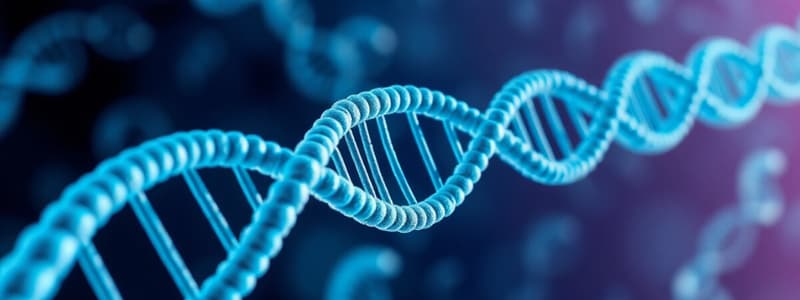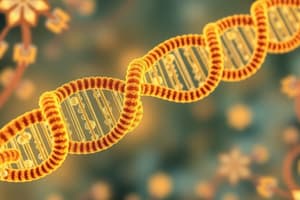Podcast
Questions and Answers
Which of the following elements are considered cis-acting elements in gene regulation?
Which of the following elements are considered cis-acting elements in gene regulation?
- Enhancer (correct)
- Proximal promoter elements (correct)
- Gene-specific transcription factors
- General transcription factors
Which of the following statements accurately describes the relationship between transcription and gene expression?
Which of the following statements accurately describes the relationship between transcription and gene expression?
- Transcription and gene expression are interchangeable terms.
- Gene expression is a broader term that encompasses transcription and translation.
- Transcription is a prerequisite for gene expression. (correct)
- Transcription is the direct result of gene expression.
What distinguishes a gene from a regulatory element?
What distinguishes a gene from a regulatory element?
- Genes are present in prokaryotes, while regulatory elements are only found in eukaryotes.
- Genes encode for proteins, while regulatory elements control the rate of protein synthesis. (correct)
- Genes are always expressed, while regulatory elements are only active when needed.
- Genes are transcribed, while regulatory elements are not.
Which of the following statements accurately describes the general transcription factors (GTFs) in eukaryotic transcription?
Which of the following statements accurately describes the general transcription factors (GTFs) in eukaryotic transcription?
What is the primary difference between eukaryotic and prokaryotic transcription?
What is the primary difference between eukaryotic and prokaryotic transcription?
What is the significance of the statement "Transcription is highly selective and tightly regulated"?
What is the significance of the statement "Transcription is highly selective and tightly regulated"?
What is the main distinction between Coding RNA and Non-coding RNA?
What is the main distinction between Coding RNA and Non-coding RNA?
Which of these Non-coding RNAs is primarily associated with the silencing of gene expression?
Which of these Non-coding RNAs is primarily associated with the silencing of gene expression?
What is the main role of rRNA, and how does it contribute to protein synthesis?
What is the main role of rRNA, and how does it contribute to protein synthesis?
How does the transcription process, as outlined in the text, differ from the DNA replication process?
How does the transcription process, as outlined in the text, differ from the DNA replication process?
Flashcards
Central Dogma
Central Dogma
The process of DNA → RNA → proteins transformation in cells.
Transcription
Transcription
The process where DNA is converted to RNA, requiring RNA polymerase.
Coding RNA
Coding RNA
RNA that encodes instructions to synthesize proteins, primarily mRNA.
Non-coding RNA
Non-coding RNA
Signup and view all the flashcards
tRNA's function
tRNA's function
Signup and view all the flashcards
Gene
Gene
Signup and view all the flashcards
Cis-acting elements
Cis-acting elements
Signup and view all the flashcards
Trans-acting elements
Trans-acting elements
Signup and view all the flashcards
Exon
Exon
Signup and view all the flashcards
Intron
Intron
Signup and view all the flashcards
Study Notes
Transcription Overview
- Transcription is the process of creating mRNA from a DNA template.
- DNA acts as a template for transcription.
- RNA polymerase is required.
- Unlike DNA replication, transcription is highly selective and tightly regulated.
- Transcription is a cellular process that synthesizes RNA.
- This includes coding RNA and non-coding RNA.
Transcription Process
- The process occurs in various stages:
- Initiation: Formation of an initiation complex. This differs between prokaryotes and eukaryotes.
- Elongation: The RNA polymerase moves along the DNA template, synthesizing RNA in a 5' to 3' direction. The base-pairing rule from DNA to RNA applies here but with uracil (U) replacing thymine (T).
- Termination: The process of detaching the newly synthesized RNA strand from the DNA template. Different mechanisms of termination exist in prokaryotes and eukaryotes. In Prokaryotes termination can be rho-dependent or rho-independent. In eukaryotes, it less well understood and more complex than in prokaryotes
- In prokaryotes, one RNA polymerase synthesizes all types of RNA
- In eukaryotes, there are three different RNA polymerases, each responsible for different types of RNA synthesis.
Coding vs. Non-coding RNA
- Coding RNA (mRNA): Encodes proteins that act as various components like enzymes and structures in cells. It provides instructions for making proteins.
- Non-coding RNA (e.g., rRNA, tRNA, siRNA, miRNA, snRNA): Regulates cellular activities but doesn't directly code for proteins. It determines when and where genes turn on and off.
Gene Structure
- A gene is defined as the entire DNA sequence needed for synthesizing a functional polypeptide.
- DNA sequences include coding regions (exons) and non-coding regions (introns and regulatory elements).
Regulatory Elements
- Cis-acting elements: DNA sequences that regulate the expression of genes on the same molecule (e.g., core promoter, proximal promoter elements, enhancer, silencer).
- Trans-acting elements: Non-DNA sequences that regulate gene expression by binding to cis-acting DNA sequences (e.g., transcription factors: general and gene-specific). Includes activators and repressors.
RNA Polymerase
- RNA polymerase is an enzyme with multiple subunits, crucial for transcription.
- RNA polymerase recognizes and binds to the promoter region.
- Synthesizes mRNA using a DNA template.
- Prokaryotes and eukaryotes have different RNA polymerases.
Transcription Inhibitors
- Rifamycin: Binds to bacterial RNA polymerase, treating gram-positive and gram-negative bacterial infections. Not effective against eukaryotic RNA polymerases.
- Actinomycin D: Binds to DNA, inhibiting its use as a template for RNA synthesis. This has antibacterial and antitumor activity.
- a-amanitin: Specifically inhibits eukaryotic RNA polymerase II, which is toxic to eukaryotic cells, but not to prokaryotes.
Post-transcriptional Modifications (mRNA)
- Prokaryotic mRNA isn't modified after transcription, while eukaryotic mRNA undergoes processing.
- Three primary processing steps include 5' capping, 3' polyadenylation, and splicing.
Post-transcriptional Modifications (rRNA and tRNA)
- rRNA and tRNA of eukaryotes are modified after transcription, but bacterial rRNA and tRNA are not similarly modified.
- rRNA primary transcript is called preribosomal RNA
- tRNA and rRNA in eukaryotes undergo post-transcriptional modifications.
Transcription Initiation Complex
- Formation of the initiation complex differs between prokaryotes and eukaryotes. Prokaryotic initiation involves specific RNA polymerase binding. Eukaryotic initiation, on the other hand, involves additional transcription factors that help recruit the RNA polymerase.
Transcription Process Overview (Eukaryotes)
- Occurs in the nucleus
- Transcription factors form an initiation complex
- Pre-mRNA undergoes splicing
- Three RNA polymerases (I, II, and III)
- Monocistronic mRNA (one gene codes for one mRNA)
Studying That Suits You
Use AI to generate personalized quizzes and flashcards to suit your learning preferences.




